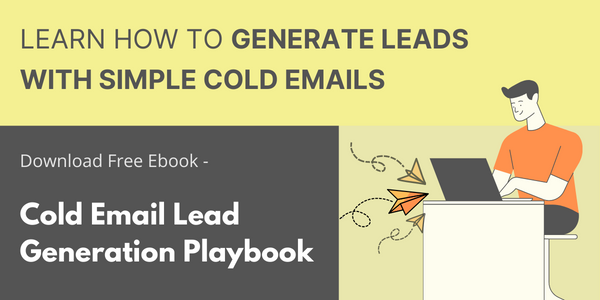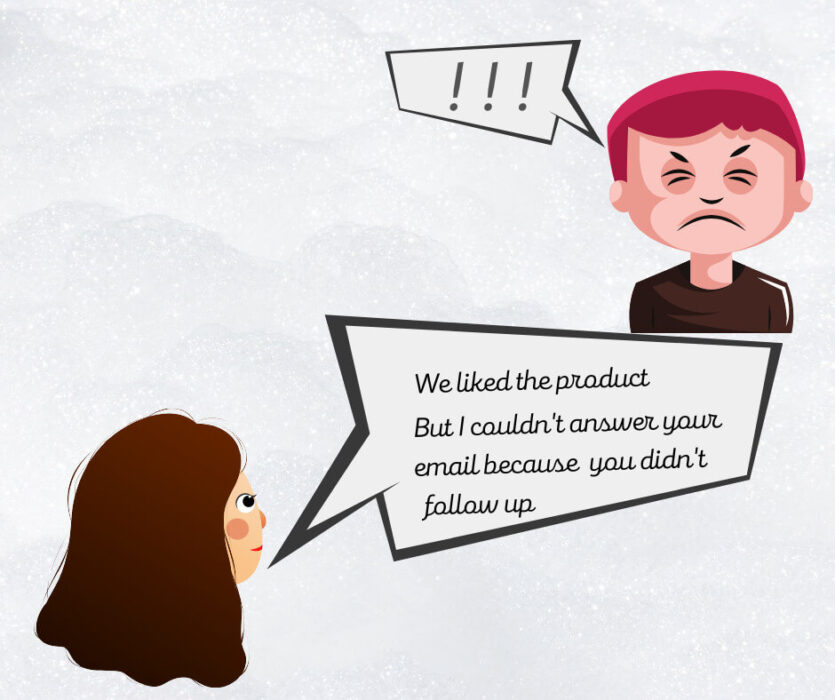If writing a follow-up email makes you feel a little anxious, you’re not alone in this. Our instincts tell us that if someone hasn’t replied to our first email, chances are they’re not interested.
Fortunately in this case, our instincts are often wrong. Very few prospects say “yes” to the first ask – or, for that matter, to the second, third, or fourth.
In fact, a study from Iko System saw an 18% response rate to the first email they sent, and 13% to the fourth. The sixth email in the sequence received a massive 27% response rate.
Type of content
1. Importance of a follow up email
2. When should you be sending a follow up email
3. How to write a follow up email
4. Follow-up email templates
5. Conclusion
Importance of a follow up email
But really how important is it to follow up with your customers?
The truth is it’s very important!
In fact, it’s become so important that poor follow up is now cited as the biggest consumer complaint!
A study by Harvard Business Review found that 56% of customers complain about poor follow-up.
While 48% of customers that experience a poor follow-up will go on to tell at least 10 people or more about their bad experience.
That’s right.
Something as simple as a follow-up ruins the entire customer experience, which, according to research, is one of top factors for doing business with a company.
So, to avoid customers turning their backs on you, you need to follow up.
But, when and how?
When should you be sending a follow up email
In email marketing, timing is a huge factor that will determine whether you’re successful. A 30-minute window could mean the difference between your email being clicked, read, and being deleted without a moment’s hesitation.
There’s a lot of guidance out there about when to send a follow-up email, but it’s important to remember that nothing will be as effective as A/B testing your own data.
Tuesday, Wednesday, and Thursday have traditionally been favorite days to send email campaigns, as email marketers seek to avoid the Monday angst and Friday’s itchy-feet.
Tuesday and Thursday are the two most popular days to send email newsletters.
However, it’s also essential that you use best deliverability practices and also regularly monitor email deliverability and opening rates to formulate effective strategies.
How to write a follow up email
- Define the purpose of your follow up email
- Create an email subject line
- Open with context
- Induce a Call-to-action
- Close and send the follow up email

1. Define the purpose of your follow-up email
First things first. You want to determine exactly why you’re sending your follow-up email. If you have a detailed funnel, this step will be much easier.
For example, let’s imagine that a member of your team met with a prospect at an event last week. Afterward, you sent an email with details of your product / services. But the lead has since gone cold and now you want to revive the conversation. In this case your objective would be to send a gentle reminder and gauge the interest of this prospect.
Now that you have this objective in mind, you can think about how to achieve it with your follow up email. For example, you might decide to send a piece of educational content about your product / service along with a gentle reminder. If the prospect clicks and downloads your educational material, that will show his interest in what you have to say.
2. Create an email subject line
Now that you have determined the purpose and got it out of the way its time to focus on the email subject line.
With your subject line, you have a small window of opportunity to capture the attention of your recipient. So you have to capitalize on it as much as possible.
Your target audience has a limited amount of time, and they want emails that respect these terms. You should make sure that your subject line is as clear as possible, and that it helps your recipient decide whether they want to read it.
Since you are writing a follow up email, you can also use the subject line to establish familiarity by referring to any previous conversation with the prospect. For example – “We met last week at XYZ conference”. Emails are way more likely to be opened if they are coming from a familiar source. So use the subject line carefully to create familiarity.
Here are a few more best practices for writing effective subject lines that will come in handy.
3. Open with context
Emphasizing and providing context around your initial communication, email, conversation, or interaction will help jog their memory and make it easier for them to understand your email and respond.
Again, people are more likely to read and respond to emails coming from familiar sources. So make an effort to create that familiarity.
Be sure to start your email with this context so your email recipient knows who you are and what you’re following up about — the last thing you want to do is confuse the person (or people) you’re looking to impress and do business with.
Here are some examples of strong email openers for you to consider using in your follow-up to provide your recipient with the context they need.
Effective Email Openers
- We met last week at the [Name of Event or Location].
- I was inspired after you spoke at the [Name of Event].
- Our friend, [Mutual Friend’s Name] suggested that I reach out.
- Last time we spoke about… [Topic].
- I’m reaching out in regards to the email I sent a few weeks ago about [Topic].
4. Induce a call-to-action
Make it easy for the recipient to respond. For example, if you’re trying to arrange a meeting, suggest a specific date and time (and place, if you’re arranging an in-person meeting).
Some examples –
- What time works for you the best? Does Thursday work for you?
- Are you the right person to talk to about this? And if not could you please connect me to the right person.
- Just reply ‘yes’ if you’d be interested in getting some more information and I’ll send a couple of short docs over.
A lot of marketers and sales personnel make the mistake of leaving it vague and ambiguous. Make your call-to-action crystal-clear and hard to resist. What exactly do you want them to do? Tell them.
5. Close and send the follow up email
Wrap up in a way that feels natural to you and is sympathetic to your interactions with the recipient so far.
Your follow-up email is written — there’s an objective behind it, you open with context, your purpose is clear, and you’ve decided on a subject line. Now you need to decide when you’re going to hit “Send”.
Based on your specific situation, you’re going to want to send your follow-up at a certain time to ensure your message remains relevant to your recipients and has the largest chance possible of being opened.
Follow-up email templates
Here are a few templates to demonstrate how to write an effective follow up email.
1. Subject line: 10 ways to boost your skills
 |
| Subject: 10 ways to boost your skills |
| Hi {{First Name}}, When we met recently, I noticed your interest in {{subject of blog}}. When I saw that our publishing team had put together {{blog or article name plus hyperlink}} I immediately thought that you would enjoy reading it. I’d really like to hear your thoughts on this and discuss how we can help you achieve {{objective}}. Could I give you a call some time? When would it be convenient? Warm regards, {{Signature}} |
 |
2. Subject line: Any questions, Joe?
 |
| Subject: Any questions, #First Name#? |
| Hi {{First Name}}, Last we spoke, you requested that I get in touch in a few months to discuss how {{Company Name}} can help your business achieve [goal]. I may be a few weeks early, but I thought I would check in. Have you given any additional consideration to my proposal? I’d be happy to chat on the phone and answer any questions that may have come up. What does your schedule look like this week to talk? Warm regards, {{Signature}} |
 |
3. Subject line: Right time to connect?
 |
| Subject: Right time to connect? |
| Hi {{First Name}}, I’m sorry we haven’t been able to connect. When we last spoke, you seemed very interested in {{objective of product or service}}. I realize that you are most likely incredibly busy, so I am happy to schedule a call with you at any time, even if it falls outside regular office hours or on a weekend if that makes it easier for you. I really would appreciate some indication on your decision either way. Thanks in advance. Warm regards, {{Signature}} |
 |
4. Subject line: We have a little surprise for you!
 |
| Subject: A little surprise for you! |
| Hi {{First Name}}, I know how busy you must be managing your team and helping them increase {{job function}}. I sent you some information about {{product or service}} a while ago and I thought this might be a good time to give you a practical demonstration. I’ve created/attached a few free samples/vouchers that you can use to access our products and service. Feel free to share these with your staff and colleagues. I’d be very interested to hear what they think of it. I would really like to have 30 mins of your time as I feel we can really add value to your {{area of operations}}. Can we book a call or a meeting? Warm regards, {{Signature}} |
 |
Conclusion
Follow up emails have the power to convert leads, bring in new business, build strong relationships, and close deals.
These pointers and follow-up email templates will give you a few pointers on how to write an effective follow up email. You can use them as starting points to create a sequence of cold email and subsequence follow up emails. You’ll need to adapt these templates to suit your clients and market, but they should serve you well in improving the response rate to your follow ups.
If you want to transform your customer service procedures and impress your customers, then start sending a follow up email to them. This simple, yet effective strategy is only used by 3% of all companies – representing a huge opportunity to gain a competitive advantage – and one that should not be missed!


Leave a Reply